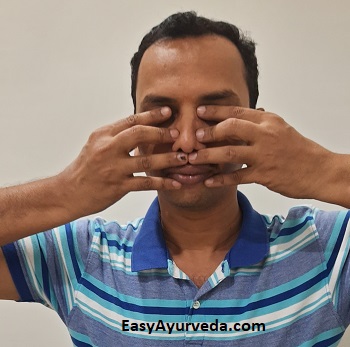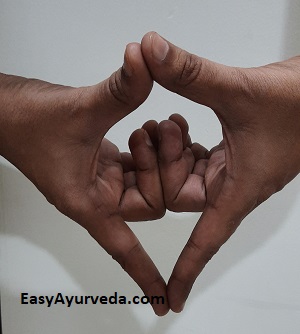Yoni Mudra Or Shanmukhi Mudra – Meaning, Procedure, Benefits
By Dr Raghuram Y.S. MD (Ay) & Dr Manasa, B.A.M.S
Yoni mudra is one of the important hasta mudras i.e. hand gestures. It helps you to get detached from the world, just like the baby in the womb. The fetus is totally detached from the issues and tensions from the external world. You will have a same feel while doing this mudra, safe as in womb. It also helps you to travel to your inner self. The word Yoni also signifies ultimate Brahman or Brahmayoni.
Read – Mudra – The Science Of Gesture: Benefits, Types, How To Practice
Table of Contents
Meaning
Yoni = vagina / womb / uterus
Mudra = gesture / lock / pose / seal / mark
Other name – Shanmukhi Mudra, Shad = six, Mukhi = openings or orifices, in this gesture the six orifices i.e. two ears, two eyes, nose and mouth with the help of your fingers. It is named as the ‘seal of the goddess’. Shanmukhi is actually a variant of Yoni gesture.
Read – Akasha Mudra For Body Stability, Vata Balance

Procedure
There are more than two variants of yoni mudra which are explained and practiced. I will explain two most common variants of this womb gesture.
Variant 1
- Sit comfortably in a calm and serene place devoid of noise. Preferably sit in Siddhasana i.e. accomplished pose. Padmasana i.e. lotus pose or any other meditative posture can be taken as per convenience.
- If sitting on the floor is not comfortable, sit on a firm chair with an erect backrest. Keep the body and spine erect. Close your eyes.
- Take your hands close to your ears, the right hand to the right ear and left hand to the left ear.
- Close your ears with the thumbs. Close the eyes with the index fingers. Close the nose with the middle fingers.
- Now close the mouth by keeping the ring fingers above the upper lips and the little fingers below the lower lips.
- Ensure that your elbows are at shoulder level, parallel to the ground.
- Make your lips into the form of a crow’s beak. This is called Kaki Mudra or crow gesture. Now suck the air into your lungs from the mouth. The nose should be closed with middle fingers.
- Perform Moola Bandha or the root lock to merge the prana and apana.
- Close your mouth and exhale the air through the nose. You can also prefer holding your breathe inside for some time and then exhale the air through the nose.
- While doing the gesture, concentrate on your breathing. The mind may wander to other thoughts but gently bring it back to the breath.
- This completes one round of practice. Practice as many rounds as you can.
- If you are comfortable in holding the breath, then rotation of conscious along the chakras can be simultaneously practiced with each breath.
Release –
- Remove your fingers gradually from their contact with your ears, eyes, nose and mouth.
- Bring your hands on to your thighs.
- Relax and breathe free.
Variant 2

Benefits
- The pranic energy which exists from the extremities will get transferred to the eyes when you close the eyes during the gesture. Just like this, the other fingers will transfer the energy from the limbs to other parts of the face. This stimulates the nerves and relaxes the muscles of the face.
- The womb gesture enables introversion in the practitioner. It helps him to withdraw his senses from the external world. This is called pratyahara. This state is a prelude for practicing meditation and Samadhi.
- This gesture is also known by the name ‘Nada Yoga’ or ‘Nada Mudra’. Nada means sounds. When you close the ears in this gesture you hear some inner sounds. You need to concentrate on these sounds. This leads to higher states of consciousness. This becomes possible as we become aware of subtle and subtler sounds. These sounds are also called as Mystic sounds. Right handed people predominantly hear these sounds from the right ear and the left handed people from the left.
- This gesture is used to awaken the Kundalini.
- Regular practice of this gesture destroys all the sins according to Gheranda Samhita.
- We visualize the important events and milestones of our life and also those memories which have left an impression on our life. Once you master the art of this gesture, you also start hearing the voice of your inner conscience which had been subdued due to the influence and pressure of the external world.
- Provides the required pause needed for a change of perception
- Brings the distracted mind to a state of attentiveness
- It is a good remedy for stress and depression
- It balances the nervous system
- Brings about rejuvenation of mind, senses and soul, keeps you relaxed
- Beneficial to develop mental peace
- Brinks clarity of thoughts
- Provides spiritual calmness and peace to one’s heart and mind
Variant 2
- Bring both hands to the lap
- Getting the hands closer to each other let the back of your middle, ring and little fingers touch at the middle phalanx. Now your fingers are pointing downwards.
- Make the tips of thumbs and index fingers of both hands touch each other. Move the touching thumbs and forefingers away from each other making a diamond shape in between them. The joined thumbs are pointing upwards and the joined forefingers are pointing downwards. The total gesture gets the shape of a womb now. The other three fingers which are curled towards their respective palms and are in close opposition to each other are visible through the opening of the diamond.
- Addition to gesture (other opinion) – the tips of the thumbs in contact should be pressed into the navel. The tips of index fingers in contact point downwards, below the point of the navel. Now tuck in the chin. Close the eyes and focus on the navel and the mudra.
Benefits
- Balances both right and left energies of the body
- Promotes flow of energy
- Gives mental stability and clarity, calms the mind
- Helps in detachment with the outside world and experience a state of bliss
- Improves focus
- Alleviates stress
- Increases prana and prevents dissipation
- Strengthens the nervous system
Related Videos
Time and duration
Yoni Mudra can be practiced at any time of the day but early morning is preferable. Practicing the mudra in seated position or in Yogic poses is beneficial. You can chant mantras while performing the gesture. It can be done after food, but is preferable on empty stomach for better results. You can practice this mudra anytime you need to detach from daily life.
Word of Caution
This mudra should be practiced under proper guidance. Those suffering from too much of introversion or depression shall avoid this gesture. It is ideal to purify the body through Shatkarmas before practicing this gesture.
Read – v
Relation with Chakras
Yoni Mudra invokes the primal energy in the Muladhara Chakra i.e. root chakra.
Impact on the doshas
This gesture mainly stimulates the apana vata. The mudra balances the vyana and prana vayu because it enables flow of energy. Since it soothes mind, promotes attentiveness and clarity of thoughts, balances nervous system and cures stress and depression, it balances all three doshas, especially those located in the head. Thus it balances the prana vayu – sadhaka pitta – tarpaka kapha axis.
Click to Consult Dr Raghuram Y.S. MD (Ayu) – Skype










One comment
E Vishwanathan
Your write ups are very informative. The instructions on mudras are very useful. If all articles on mudras are consolidated one can make hard copies for practice and reference.